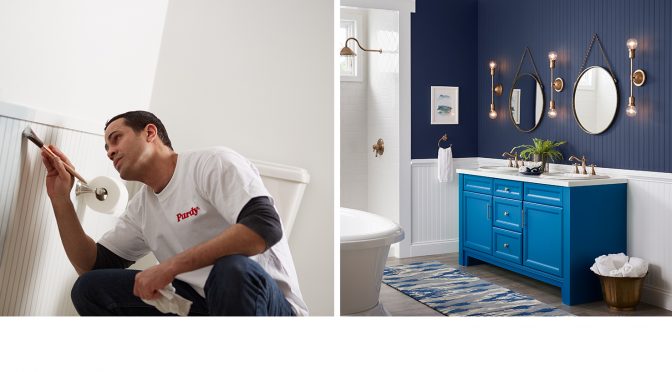Of all the rooms in a typical residential repaint, bathrooms are among the most challenging for professional painting contractors.
Blame it on water. Humidity levels in bathrooms are always rising and falling, and damp air and steam collects on walls. That makes bathrooms prone to mildew and moisture problems. Water also inevitably splashes on bathroom walls, doors and windows, and sometimes there is water damage to deal with as well.
Your paint needs to be up to the challenge. You need a durable, washable and moisture-resistant coating to do the job right.
Using a high-quality acrylic latex paint such as Duration Home® can make all the difference between success and failure on bathroom repaint jobs, says Rick Watson, director of Product Information and Technical Services at Sherwin-Williams.
The key is the product’s advanced Moisture Resistance Technology™.
“Duration Home’s Moisture Resistant Technology has been validated through extensive lab testing and product benchmarking,” he says. “It offers quick return to service and durability in moist environments like bathrooms with little risk of coating failure due to water spotting or color rub off.”
The exclusive cross-linking technology in Duration Home actually repels stains. Most stains wipe clean with water or mild soap, reducing the unsightly streaking that can mar the surface after applying lower-quality paints.
As little as two-hour turnaround time
Moisture Resistant Technology also has another benefit for pro painters: a quick turnaround time. The bathroom can be ready for homeowner use in as little as two hours after painting, Watson says. Anti-microbial agents also inhibit the growth of mold and mildew on the painted surfaces.
The product is available in four sheens, including a technologically advanced flat finish that offers the same washability, durability, moisture resistance and burnish resistance as the matte or glossier sheens. With Duration Home Flat, there is no need to sacrifice performance for appearance. The flat finish hides minor drywall imperfections while providing a washable, rich look.
How to prep the surface before painting
One last note: When painting bathrooms, extra care in surface preparation is also warranted.
Before repainting a bathroom, make sure the walls are clean. This is key for proper paint adhesion and to prevent future peeling problems or unsightly surfactants from leaching/streaking through.
Surfactant leaching is a term used when a concentration of water-soluble paint ingredients called “surfactants” are noticed on the surface of a latex paint film. Surfactant leaching is most commonly seen as a streak or stain of tan, brown, or clear spots that sometimes can be glossy, soapy, oily or even sticky. Surfactants are soap-like materials that help in the dispersion of the paint’s pigment and latex binders.
Duration Home with Moisture Resistant Technology has excellent resistance to surfactant leaching when applied on new or existing substrates. However, surfactants can remain on existing painted surfaces if not removed prior to coating. Existing painted surfaces must be thoroughly washed clean and allowed to dry prior to applying any finish.
A good cleaner degreaser/emulsifying cleaner (dish soap) is a good bet to get rid of accumulated soap scum and other contaminants. Remove mold and mildew and don’t forget to clean the exhaust fan.
Bottom line
Proper prep, attention to detail, and a top-quality coating will help you tackle one of the most challenging residential interior painting problems and give your customers a beautiful bathroom finish that cleans up well and lasts a long time.
Rick Watson, director of Product Information and Technical Services at Sherwin-Williams, answers pro questions in the Ask Your ProPartner™ column in PPC magazine.
Got a question for Rick?
Use our secure email contact form

